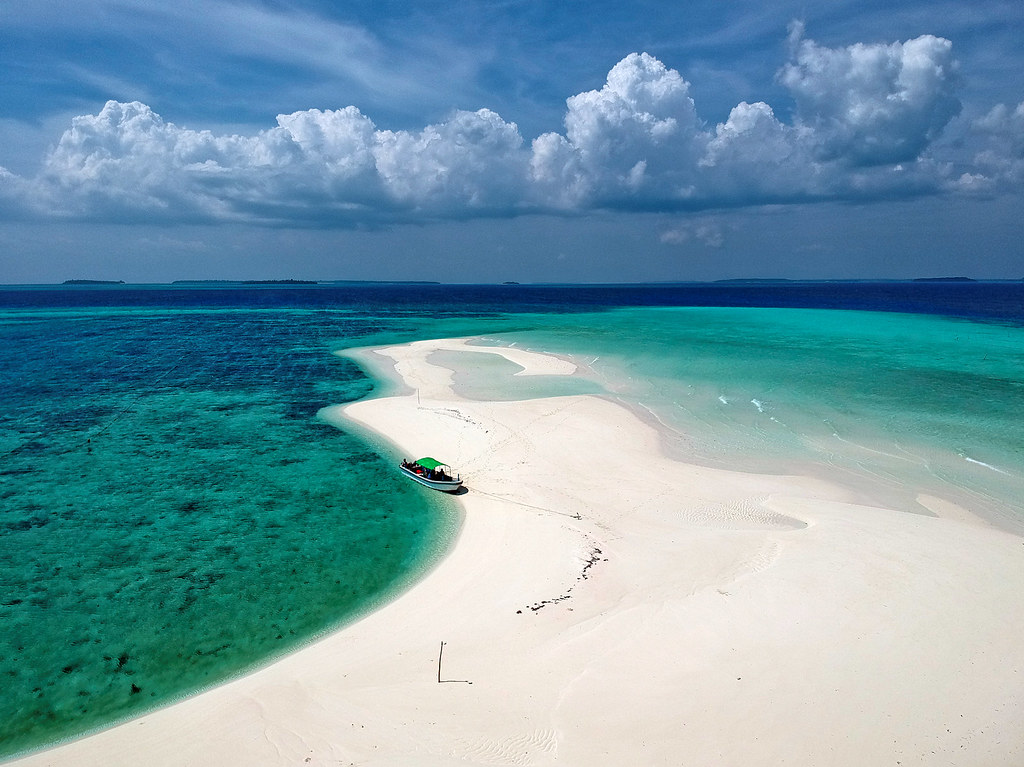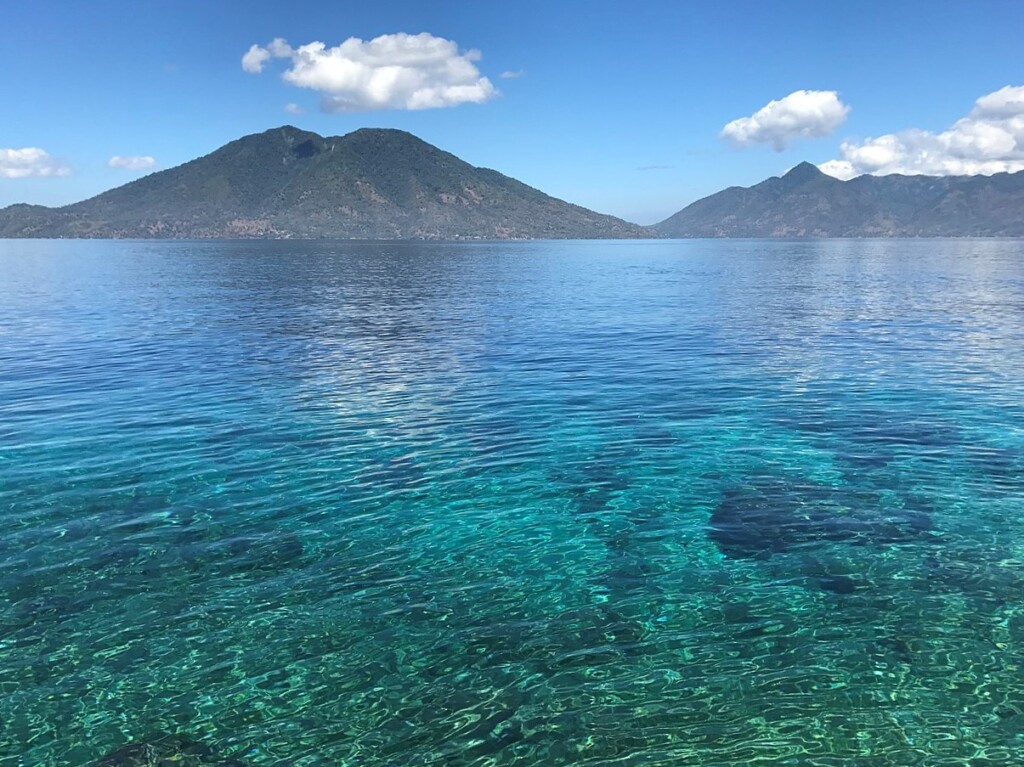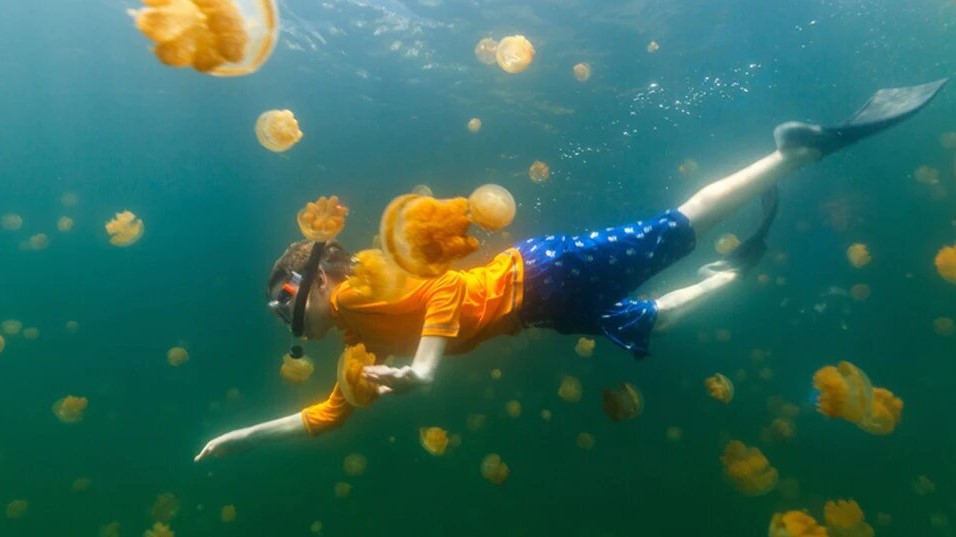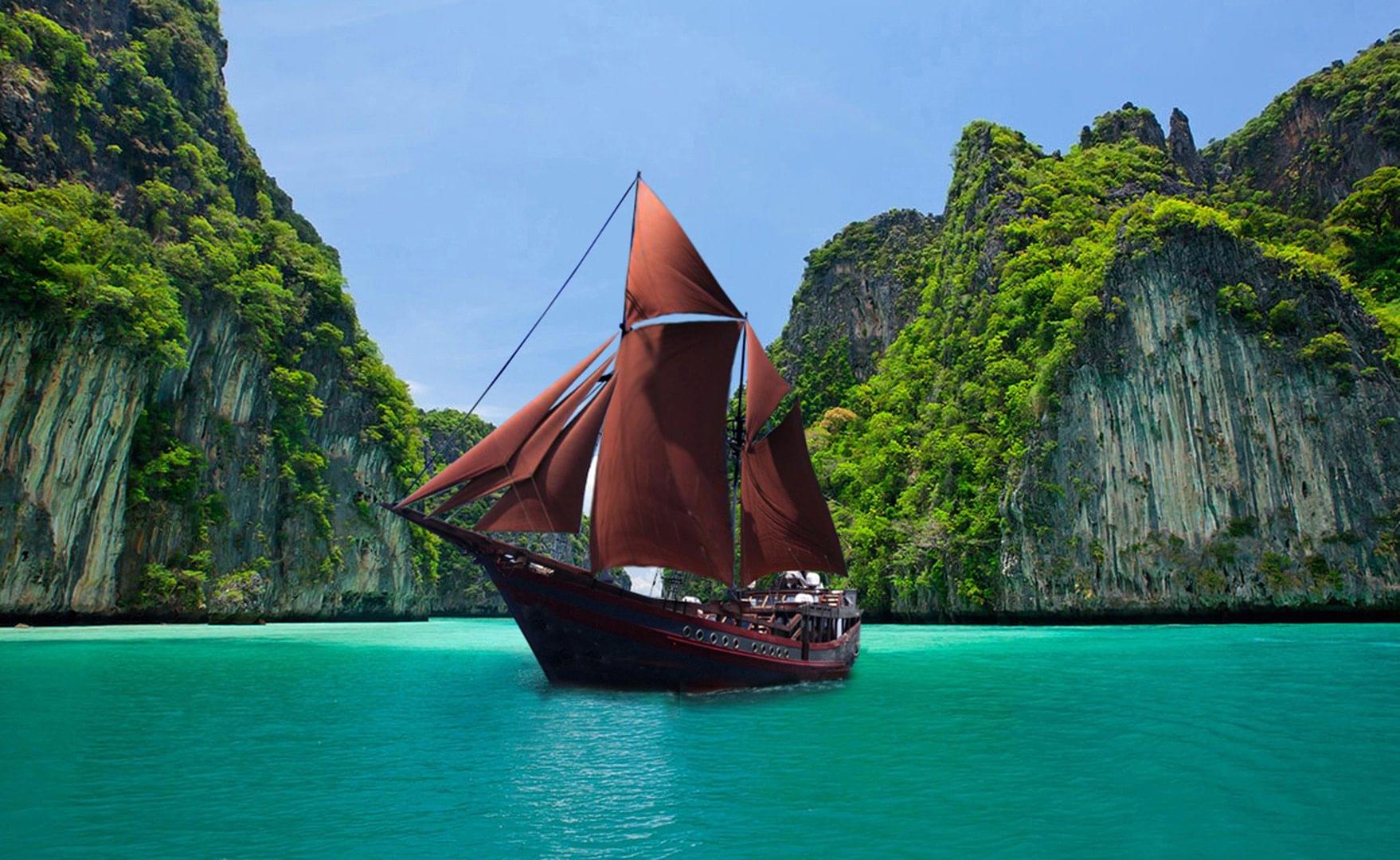April 9, 2022
Off The Beaten Track Route
Indonesia's impressive fleet of luxury yachts offers opportunities to explore even more exciting "off the beaten track" destinations. Featuring some of the archipelago's most recently discovered remote hotspots, they hold the possibility of exploring where very few have ever travelled before. Below are some of our suggestions to add to your bucket list.

#01 - The Forgotten Islands, South Maluku:
Best time to visit: April to May & October to November
The Forgotten Islands' cruising grounds are a little different from other destinations in Indonesia. Located between the eastern end of Nusa Tenggara and the coastline of West Papua, this itinerary follows a chain of imposing volcanic islands. This "arc of fire" rises above the ocean's surface from a colossal marine mountain range. Known as the Damar Ridge, this marks the southern boundary of the deep Banda Sea.
A short distance to the south of this chain of volcanoes is another, the less prominent curve of larger islands. These include the Tanimbar and Kei groups, which offer very different landscapes. These mini archipelagos are home to some of the most pristine seascapes in all of Indonesia. Traditional, idyllic tropical beaches backed by emerald green forests make a stark contrast to the fiery mountains further north. Endless white sand beaches mighty volcanoes morph into vibrant coral reefs, which plunge vertically into the deep blue of these abundant seas. Big fish diving over the legendary reefs and rarely visited remote atolls of the Forgotten Islands is a marine explorer's dream. There is a good chance of spotting some of the ocean's more giant creatures. Schooling hammerhead sharks are often encountered at numerous sites, and sea snakes are common, especially around the islands of Manuk and Gunung Api.

#02 - Cenderawasih Bay, North-West Papua:
Best time to visit: April to November
Located along the northern coastline of West Papua, Cenderawasih Bay, Indonesia's largest national park, forms part of what is known as the Bird's Head Seascape. Relatively new to the Southeast Asian luxury yachting community, Cenderawasih Bay is one of the latest additions to Indonesia's already outstanding portfolio of cruise itineraries. The bay harbours a natural beauty becoming a south Pacific paradise. The remote islands and strikingly colourful coral reef systems scattered inside the bay are significant exploring areas. Rising from the deep blue sea, the crystal-clear waters and sparkling reefs teem with marine life. The picture-perfect beaches surrounding many tiny tropical islands appear to have been man-made for some grand advertising campaign. These create fantastic locations for a range of watersports, beach-combing, and private sunset barbecues. The surrounding mainland and islands are home to a host of rare creatures. Living in the lowlands, gorges, and hilly forests are endemic to the region, including forest wallabies, possums, bandicoots, and the sleepy and secretive cuscus, all potentially spotted during treks through the woods.
The continental-sized island of Papua has the largest concentration of bird species on the planet, along with the Amazon. Cenderawasih Bay is home to many of them, including the elusive and rare "Birds of Paradise". However, the main attraction and the stars of a Cenderawasih Bay luxury cruise are the awe-inspiring, up-close-and-personal whale shark encounters deep inside the bay at Kwatisore. Snorkelling with these impressive creatures in the wild is a humbling experience, and Cenderawasih Bay features an excursion second to none. The local fishermen sling nets underneath their tethered fishing platforms to catch baitfish at night. These gigantic fish like to gather below the yields to suck up a free meal. This activity has attracted the attention of the local whale shark population. Numerous whale sharks are often observed during a single excursion, creating a truly spectacular experience for snorkelers and divers alike. Geologically separated from the southwest reaches of the Pacific Ocean by a deep marine ridge stretching across its northern border, Cenderawasih Bay offers many features and creatures not found at other destinations, making it a unique and unusual cruising ground for adventurous luxury yacht exploration.

#03 - Triton Bay, South-West Papua: Welcome to the Jungle
Best time to visit: October to June
Triton Bay is located along the wild southwest coastline of southwest Papua, on the south side of what is known as the Bird's Head Peninsula, and is another of Indonesia's exceptional "out of the spotlight" cruising destinations found in the eastern region of the archipelago. Pristine land and seascapes, where few exploration or dive vessels have ventured, hide a wealth of wonders waiting to be discovered. Exciting forest treks, extraordinary high waterfalls, prehistoric rock art, and mystical river excursions, combined with an array of sublime dive sites, are just some of the exciting activities to experience at Triton Bay and the outlying areas.
Dazzling snorkelling sites to satisfy even the most inquisitive marine life fanatics are found everywhere. Watersports enthusiasts will be thrilled to find a wealth of surreal kayaking routes to explore. High forest wooden walkways have been constructed to allow trekkers to experience Triton Bay's breathtaking scenery panoramic views. Primitive rock art displayed on the vertical walls of the high limestone cliffs provides another standout experience for culture vultures. Excursions to the village of Lobo, deep inside the bay, provide visitors with a glimpse into the lives of the local people. Lobo also serves as a starting point for an exciting river expedition that reaches far into the mangroves and forests of the Papuan mainland. There is also the chance to visit some of the remote settlements along the river banks. These remarkable adventures allow intrepid explorers to see some of the region's fascinating flora and fauna.
Another of Indonesia's locations to encounter the ocean's largest fish, the mighty whale shark, is close to the island of Namatote, at each end of the narrow strait separating it from the mainland. The Nematode Strait is a favourite anchoring place for local fishing platforms known as pagans. The fishermen's primary activity of catching small baitfish for use in Asian cuisine lures these majestic giants in for a free meal, like a fast-food restaurant for behemoths. Often, during these marine banquets, other guests sometimes turn up too. Pods of dolphins and sleek sailfish are frequently spotted taking part in the frantic feast.
The underwater wonderland of Triton Bay is a scuba diver's dream destination. Decorated with some of the best soft corals to be found anywhere on the planet, the inner reefs at Triton are home to a wealth of unusual marine life, some of them endemic to the bay, such as a unique species of walking shark. Facing the open sea, the more exposed reefs, rocks, and seamounts are no less alluring. Teeming with schools of fish and astonishingly colourful coral, these topographic oceans turn the excitement level up to eleven.
Further outside the bay, around what is known as the Bomber Peninsula, there are even more impressive sights to check out. Upstream from the pristine white sand beaches, huge waterfalls have formed in the rivers of the Papuan forests. Some natural wonders plunge over 70 metres from high rocky precipices before thundering into rocky pools below. One of the more unusual examples, called Kiti Kiti, even cascades directly into the ocean, a dramatic and very scenic spectacle. Triton Bay and the surrounding land and seascapes are now firmly on the list of Indonesia's favourite destinations, in a region that should already be on every adventurous luxury cruising yacht's radar.

#04 - East Nusa Tenggara, Maumere to Alor: Fire & Water
Best time to visit: March to November
The continuation of the Nusa Tenggara archipelago further east of Komodo includes the islands of Flores, Adonara, Solor, Lembata, and Pantar before ending at Alor. This multifaceted cruising destination features active volcanoes, dazzling coral reefs, and magnificent deserted beaches, combined with ancient tribal culture and dance performances.
This seldom travelled route stretches for nearly 200 nautical miles from Maumere, the regional capital of northern Flores, to the shores of Alor Island. This sparsely populated chain of islands, home to some of the friendliest people in the country, is one of Indonesia's best-kept secrets. The cruising itinerary features incredible landscapes with many volcanoes dominating the skyline, current-swept channels surging between the islands, plenty of bays and coves to explore, and a wonderfully complex coastline.
Flores
The scenery of mainland Flores is breathtaking. Excursions to the architecturally perfect circular rice fields of Manggarai, the Keli Mutu volcano with its three coloured crater lakes, and many more scenic locations are all very popular. Hiding in the island's central highlands is the megalithic village of Bena. Located close to the Inierie volcano, this preserved centre of ancient culture features traditional homesteads and sanctuaries of worship.
Lembata
Moving further along the island line, we come to Lembata, a world that, in many ways, has been left behind in time. The coastal village of Waipukang, located in Washing Bay, is tucked under the shadow of the sacred and very much active volcano of Mt. Lewotolo. From Waipukang, it is possible to trek up the perfect volcanic cone of this mighty smoking beast. According to the locals living underneath the mountain, their ancestors arrived from the north on great ships countless generations ago. High up on the mountain slopes, they still practice their animist beliefs during an annual harvest ceremony at the sacred but deserted village of Lewo Hala. A time of grand celebration, with singing, dancing, and religious offerings. Several more active volcanoes rise above Lembata's dry, undulating landscape of grassland, forests, and a complex coastline. The island also features numerous winding country lanes, great for hikes and inland treks. Especially if you like to meet up with the inquisitive and excitable locals.
Pantar & Alor
Pantar and Alor are the last two islands in the chain, separated from Lembata, and each other, by broad current washed channels. The southwest part of Pantar is a perfect location for luxury cruising yachts. The bays and coastline feature wonderfully scenic anchorages and dozens of deserted white sand beaches fronted with colourful coral reefs. The Lembata/Pantar Strait is often described as a mini Komodo.
Alor, the most easterly island in the East Nusa Tenggara archipelago, is a little different from those preceding it. The strait that divides Alor from Pantar is distinguished by three large islands, Buaya, Ternate and the largest, Pura. These "islands in the stream" are pounded by solid tides and feature more of Indonesia's pristine coral reefs and villages buzzing with warm and welcoming locals. The port town of Kalabahi, on mainland Alor, has by far the largest concentration of population in the region. This vibrant metropolis is the gateway to one of the island's most fascinating cultural experiences, ceremonial dance performances by the locals.
Abui Tribe at Takpala village
Their name, Abui, translates to "The People of the Mountains'', and as this suggests, they inhabit the island's central highlands. Once headhunters and animist-ancestor worshippers, the Abui maintained much of their architecture and crafts. Takala is the centre of Abui culture and where one of the most evocative of these performances is performed. The "Lego-Lego", a circular dance accompanied by gongs, drums and chants, traces the tribe's history. Ancient bronze drums known as Moko are used in these colourful trance-like displays. These time-worn instruments, believed to have originated in old Vietnam, are considered to have powers to cause the heavens to open with rain.
Ikat Fabric Weaving
East Nusa Tenggara is famed for its intricate ikat textiles, and the islands and villages of the region have their specialist weavers. The more elaborate depict abstract symbols and stylised sea animals, including whales, dolphins and manta rays. Some are especially prized for their deep red colour, which can only be achieved by master dyers using secret formulas handed down from generation to generation from mother to daughter.
Scuba Diving
The scuba diving opportunities along this mini archipelago are spectacular, with sites to suit every taste. The reefs, rocks, and seamounts are some of the most pristine to be found in Indonesia, and the clarity of the water can be exceptional. There is plenty of marine life to see, with larger species such as oceanic sunfish and many shark varieties, including hammerheads and threshers, making regular appearances. The islands' channels serve as giant marine thoroughfares for cetaceans on their annual migrations, with frequent sightings of blue whales and even orcas. Alor's Kalabahi Inlet, although not having the incredible visibility of other areas, plays host to many world-class critter dive sites. Here, divers can search for the weird and wonderful marine life that makes Indonesia's diving destinations special.

#05 - Derawan, Celebes Sea
Best time to visit: March to October
Located off the eastern shores of the continental-sized island of Kalimantan (Borneo), the Derawan group is another of Indonesia's prime remote destinations. The small islands of Derawan and Sangalaki combine with the mangrove forest greenery of Kakaban and the expansive atoll complex of Maratua to make an idyllic tropical seascape.
Derawan is a much smaller cruising ground than the others covered here. Isolated islands and atolls feature soft white sand beaches fringed with waving palm trees and pristine azure seas bursting with marine life. The shallow Berau river delta drops off dramatically into much deeper water a short distance offshore from the Kalimantan mainland to form a perfect tropical paradise.
Marine Life
The dazzling reefs support over 460 coral species and 870 different fish species, ranging from tiny pygmy seahorses to giant manta rays.
More incredible marine life is either a resident or a visitor to the island group. Dolphins, dugongs, barracudas, sharks, and whales can be spotted at Derawan.
Turtles
Derawan's islands are renowned as Indonesia's most significant nesting sites for endangered green and hawksbill turtles. After dark, the hardy females of the species scramble from the sea onto soft sand beaches to dig nests. Here they will lay their eggs before covering them and returning to the water. When the eggs hatch, the mini turtles pop up from the sand before scuttling into the surf to begin their new life in the ocean.
Kakaban Jellyfish Lake
The emerald-green island of Kakaban hides a remarkable secret. The massive lagoon formed inside the mangroves is teeming with sting-free jellyfish, similar to those found in lakes in Palau, Micronesia, and Raja Ampat, Indonesia.
Manta Rays at Sangalaki
The beautiful islands, reefs, and atolls that comprise the Derawan Group are certainly one of Indonesia's "off the beaten track" gems. The tiny island of Sangalaki is only 700 metres across but is surrounded by a much larger coral reef. This is another of Indonesia's well-known manta aggregation centres. Encountering these mesmerising and elegant animals gliding over a coral reef should definitely be on everyone's bucket list.
Extraordinary Indonesia
The vast Indonesian archipelago now sits at the very top of the list of destinations for luxury yachts, curious explorers, and brave adventurers to visit. Her underwater world's incredible diversity, astonishing landscapes and topside historical and cultural treasures create the perfect cruising grounds with "must-see" hidden wonders at every turn.





